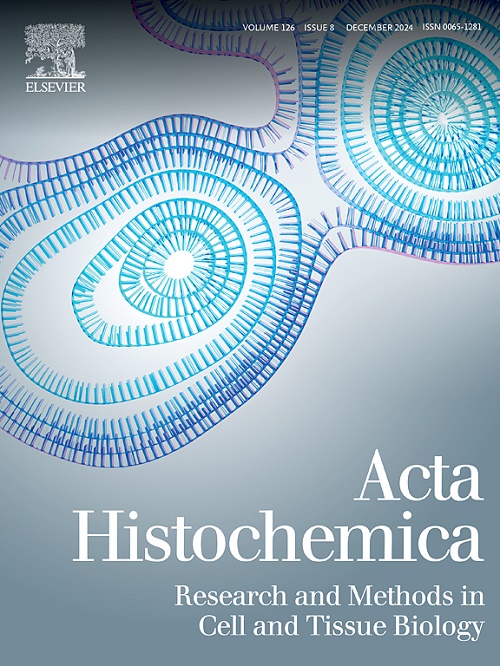New insights into persistent corneal subepithelial infiltrates following epidemic keratoconjunctivitis: The first case report with ultrastructural and immunohistochemical investigations
IF 2.4
4区 生物学
Q4 CELL BIOLOGY
引用次数: 0
Abstract
Epidemic keratoconjunctivitis (EKC) is one of the most severe clinical manifestations of human adenovirus ocular surface infection, which may lead to the formation of subepithelial infiltrates (SEIs) in the anterior corneal stroma in 20–50 % of cases. SEIs may be asymptomatic or give rise to corneal aberrations and visual impairment for months or years after acute infection, despite treatments. Here, we describe the ultrastructural and immunophenotypic features of the anterior corneal stroma of a patient who underwent superficial anterior lamellar keratoplasty (SALK) surgery to remove corneal opacities related to clinically significant and steroid-unresponsive, long-lasting SEIs after adenoviral EKC. Before femtosecond laser-assisted SALK surgical intervention, the patient underwent in vivo confocal microscopy that showed a cluster of hyperreflective inflammatory cells within the basal epithelium, associated to an abnormal sub-basal nerve plexus with a fragmented nervous component appearance. The areas corresponding to the SEIs appeared as roundish hyperreflective spots with undefined borders. Transmission electron microscopy analysis of the excised anterior corneal button revealed the presence of giant stromal cells displaying myofibroblast-like features immediately beneath the Bowman’s layer. Such abnormal cells exhibited ultrastructural signs of endoplasmic reticulum stress and autophagy, and were positive for markers of activated fibroblasts/myofibroblasts at immunofluorescence analysis. The deeper stroma was instead populated by normal stromal cells (i.e., keratocytes). This case report provides the first morphological evidence that persistent SEIs could be the macroscopic expression of subepithelial giant stromal cells with myofibroblast-like characteristics. Such a novel observation might pave the way toward a better targeted therapeutic management of SEIs.
对流行性角膜结膜炎后持续性角膜上皮下浸润的新认识:首例超微结构和免疫组织化学调查报告。
流行性角膜结膜炎(EKC)是人腺病毒眼表感染最严重的临床表现之一,20- 50% %的病例可导致角膜前基质上皮下浸润(SEIs)的形成。急性感染后,尽管经过治疗,SEIs可能在数月或数年内无症状或引起角膜畸变和视力损害。在这里,我们描述了一名患者的角膜前基质的超微结构和免疫表型特征,该患者接受了浅表前板层角膜移植术(SALK)手术,以去除与腺病毒EKC后临床显著且类固醇无反应的持久SEIs相关的角膜混浊。在飞秒激光辅助SALK手术干预之前,患者进行了体内共聚焦显微镜检查,发现基底上皮内有一簇高反射性炎症细胞,与基底下神经丛异常有关,神经成分呈碎片状。sei对应的区域呈现为圆形的高反射点,边界不明确。对切除的前角膜按钮的透射电镜分析显示,在鲍曼层下存在巨大的间质细胞,显示肌成纤维细胞样特征。这些异常细胞表现出内质网应激和自噬的超微结构征象,免疫荧光分析显示成纤维细胞/肌成纤维细胞阳性。较深的基质由正常基质细胞(即角化细胞)填充。本病例报告提供了第一个形态学证据,证明持续的SEIs可能是具有肌成纤维细胞样特征的上皮下巨大基质细胞的宏观表达。这种新颖的观察结果可能为更好地靶向治疗SEIs铺平道路。
本文章由计算机程序翻译,如有差异,请以英文原文为准。
求助全文
约1分钟内获得全文
求助全文
来源期刊

Acta histochemica
生物-细胞生物学
CiteScore
4.60
自引率
4.00%
发文量
107
审稿时长
23 days
期刊介绍:
Acta histochemica, a journal of structural biochemistry of cells and tissues, publishes original research articles, short communications, reviews, letters to the editor, meeting reports and abstracts of meetings. The aim of the journal is to provide a forum for the cytochemical and histochemical research community in the life sciences, including cell biology, biotechnology, neurobiology, immunobiology, pathology, pharmacology, botany, zoology and environmental and toxicological research. The journal focuses on new developments in cytochemistry and histochemistry and their applications. Manuscripts reporting on studies of living cells and tissues are particularly welcome. Understanding the complexity of cells and tissues, i.e. their biocomplexity and biodiversity, is a major goal of the journal and reports on this topic are especially encouraged. Original research articles, short communications and reviews that report on new developments in cytochemistry and histochemistry are welcomed, especially when molecular biology is combined with the use of advanced microscopical techniques including image analysis and cytometry. Letters to the editor should comment or interpret previously published articles in the journal to trigger scientific discussions. Meeting reports are considered to be very important publications in the journal because they are excellent opportunities to present state-of-the-art overviews of fields in research where the developments are fast and hard to follow. Authors of meeting reports should consult the editors before writing a report. The editorial policy of the editors and the editorial board is rapid publication. Once a manuscript is received by one of the editors, an editorial decision about acceptance, revision or rejection will be taken within a month. It is the aim of the publishers to have a manuscript published within three months after the manuscript has been accepted
 求助内容:
求助内容: 应助结果提醒方式:
应助结果提醒方式:


